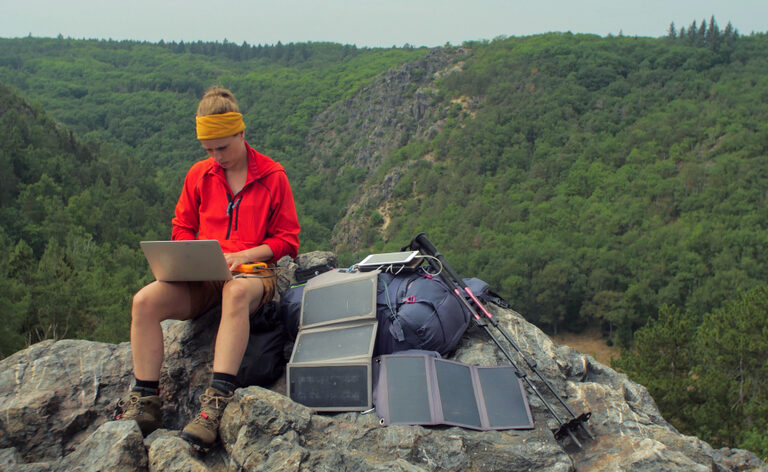Solar panels are changing the way we think about and use electricity. With portable solar panels that are both functional and accessible, it’s now possible to power your electronics on the go. But if you’re new to solar, then finding a portable solar panel that’s right for you can quickly become overwhelming.
That’s where we come in. We’ll help walk you through the important things to look out for, and tell you all about the best portable panels we could find.
- Things to Consider in Portable Solar Panels
- Top 10 Best Portable Solar Panels 2023
- 1. Best Overall Portable Solar Panel: Hiluckey Outdoor Portable PowerBank
- 2. Best Premium Portable Solar Panel: Jackery SolarSaga 100W Portable Solar Panel
- 3. Best USB Portable Solar Panel: Nekteck 21W Solar Charger
- 4. Best Universal Portable Solar Panel: Rockpals SP003 100W Foldable Solar Panel
- 5. Best Portable Solar Panel for RVs: Renogy 100 Watt Foldable Solar Panel
- 6. Best Portable Solar Panel for Outdoor Adventures: Tranmix Portable Solar Phone Charger
- 7. Best Portable Solar Panel for Light Travel: Topsolar SolarFairy 100W Foldable Solar Panel
- 8. Best Fabric Portable Solar Panel: Rockpals RP082 100w Foldable Solar Panel Charger
- 9. Best High-Power Portable Solar Panel: DOKIO 220 Watts Foldable Solar Panel
- 10. Best Budget Portable Solar Panel: IEsafy 26800mAh Solar Charger
- Everything You Need to Know About Portable Solar Panels
- Wrapping Up
Things to Consider in Portable Solar Panels
When buying something like solar panels, there are quite a few things you should keep in mind while shopping for the right one. Let’s look at some of the most important things to consider in portable solar panels.
Usage
Perhaps the most important thing to consider in a portable solar panel is what you plan to power with it. You wouldn’t buy a solar phone charger to power an RV, so accounting for what you’re planning to do with them is crucial.
Think about how you’ll use the panel: are you looking to keep your phone charged when the power goes out after a big storm? Or perhaps you’re looking to power a USB fan on your weekend next camping trip.
You should keep what you’ll use your solar panels for in mind, as this can help you gauge how much power you need. It can also help you figure out what kind of performance you should seek from your panels.
It’ll also help in determining what size panels you’ll need.
Size
When you’re buying something that’s portable, size matters a lot. And solar panels are no exception.
First, if you’re going hiking or camping, you’re probably bringing other things with you. Since you have a limited amount of space, you’ll need to factor in how big the panels are when packing.
You’ll also need to consider that the size of a panel correlates to the amount of power it can generate. So, a bigger panel will typically generate more power over a given time span than a smaller panel. If you’re planning to power multiple devices, then a smaller panel probably won’t cut it.
But when we say size, we’re not just talking about length, width, and height–we’re talking about weight too.
Obviously, weight is important. If you plan to trudge through the wilderness, you’ll need to factor in the extra weight. However, it’s not always just about slimming down to the lightest panels you can find.
For example, if you’re planning on camping in an RV, you might not stray far with your panels. But you might want a heavier panel that’s more durable and won’t blow over if the wind picks up.
Peak Wattage
Another criteria in deciding which solar panel to go with is the peak wattage a panel can produce. This goes back to the earlier example of not using a solar phone charger to power an RV. You’ll need to consider how much power you need, and go around that.
However, when using the peak wattage figure, keep in mind that the number is only a theoretical maximum, based on laboratory testing. We go into this a little more later, but expect to get a maximum of 50-75% of the rated peak wattage out of your panels.
Type of Solar Cells
For solar panels, it’s important to consider the type of solar cells that make up a panel. That’s because different types of cells can generate more or less power in a given time. So let’s take a look at the three major types of solar cells and how they differ.
Monocrystalline
Monocrystalline solar panels are panels composed of solar cells that are cut from a single, pure silicon crystal. These cells offer a superior energy conversion rate over other types of cells. However, they are also the most expensive type of solar panel on the market, since they cost more to produce than other types of panels.
You can often identify monocrystalline solar panels by looking at the color of the panels. If the solar cells are black, there’s a good chance they’re monocrystalline panels.
Polycrystalline
Polycrystalline solar panels differ from monocrystalline panels in how they’re made. They use wafers of conjoined fragments of silicon crystals, rather than whole crystals.
Because polycrystalline cells use raw materials more effectively, they’re cheaper to produce. However, they’re also not as effective at converting solar energy as monocrystalline panels.
Like monocrystalline cells, you can use color to identify polycrystalline panels. Instead of black, polycrystalline cells typically have a bluish tint. However, thin-film panels can also feature this blue tint, so don’t make any hasty judgments.
Thin-Film
Thin-film solar panels differ greatly from both mono and polycrystalline panels. That’s because thin-film panels use a variety of materials. The most common constituent of thin-film panels is cadmium telluride (CdTe).
Because of this, they are the cheapest and most flexible type of solar panels available. But they also offer the worst energy conversion rate among the three types of solar panels.
In portable solar panels, thin-film panels are most commonly found in solar phone chargers. However, sometimes there are exceptions – the Nekteck 21W Solar Charger is one such charger that actually features monocrystalline cells instead.
Now that we’ve covered some basics, let’s look at some of the best portable solar panels we’ve found.
Top 10 Best Portable Solar Panels 2023
1. Best Overall Portable Solar Panel: Hiluckey Outdoor Portable PowerBank
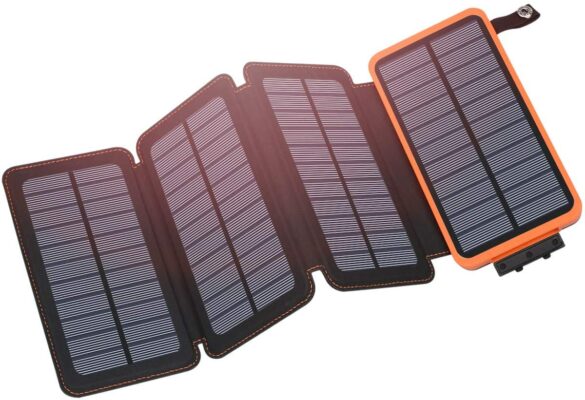
Editor’s Rating:
Quick Facts:
- Type: Thin-film
- Usage: USB device charging
- Peak Wattage: 5 watts
- Size: 6.1 x 3.35 x 1.37″ / 1.1 lbs
The Hiluckey Outdoor Portable Power Bank is a well-rounded option for hiking, camping, or just providing your phone with a sustainable source of portable power.
The 4 small solar panels provide up to one amp of input current in direct sunlight, and provide power directly to the built-in 25,000mAh battery. It also has a built-in flashlight, which can help conserve your phone’s battery life if you’re in dire straits.
The built-in battery carries enough juice to recharge most smartphones multiple times on one charge. And it offers two USB charging ports to charge two devices simultaneously. This makes it useful for providing power for your phone and tablet, as well as other creature comforts like USB fans and lights.
The biggest drawback of this solar panel is the amount of power it’s capable of generating. With a peak wattage of 5 watts, it takes approximately 35 to 50 hours for the panels to fully recharge the built-in battery with sunlight alone.
That means if you’re planning on roughing it for weeks at a time, you may need something more robust. Something like the Jackery SolarSaga 100W Portable Solar Panel is more appropriate for such long trips, but comes at a significantly higher price.
Of course, if you’re just planning on using it for a weekend trip, then you could just charge the battery before you leave and use the solar panels to maintain the battery.
Pros
- Built-in 25,000mAh Li-polymer battery
- Built-in flashlight
- Battery can be charged with a wall charger
- Allows you to charge 2 devices at once
Cons
- Takes 35-50 hours to fully charge the built-in battery with sunlight alone
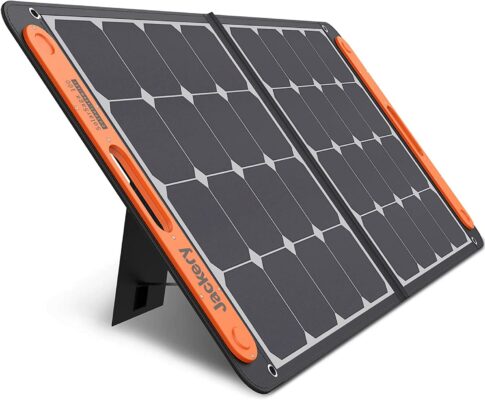
Editor’s Rating:
Quick Facts:
- Type: Monocrystalline
- Usage: Power station/USB device charging
- Peak Wattage: 100 watts
- Size: 22.83 x 19.69 x 2.36″ / 10.38 lbs
The Jackery SolarSaga 100W Portable Solar Panel offers a brilliant combination of effectiveness, portability, and ease of use. This lightweight solar panel consists of two 50-watt solar panels that are integrated into a foldable hardback carrying case. With a built-in kickstand, this panel is easy to set up, so you can start charging your power station or USB devices quickly.
Speaking of USB, this panel comes with 2 USB charging ports: a USB-A and USB-C port. It also has an integrated cable that attaches to the solar panel, so you won’t have to worry about dealing with connection issues at the panel.
Of course, this panel comes with a couple of caveats. While the panel includes a USB-C port, it’s important to note that it doesn’t support Power Delivery (PD 3.0). If you have a PD-compatible device, this is definitely something to keep in mind.
Also, despite its premium price tag, it isn’t waterproof, so you’ll need to keep it dry. If you’re looking for a waterproof solar panel, you might consider the IEsafy or Tranmix panels. Of course, those panels are solar phone chargers, meaning they won’t charge power stations. So if you’re looking for more robust power delivery, the SolarSaga is the superior choice.
While this panel comes at a premium price, it also comes with a solid 2-year warranty and excellent customer service. If you want a solar panel with superior charging performance and customer support, you can’t go wrong with this panel.
Pros
- Built-in kickstand
- Quick to set up and start charging
- Integrated cable means no connection issues
- 2-year warranty
- Excellent customer service
Cons
- Not waterproof
- USB-C port doesn't support fast charging
3. Best USB Portable Solar Panel: Nekteck 21W Solar Charger
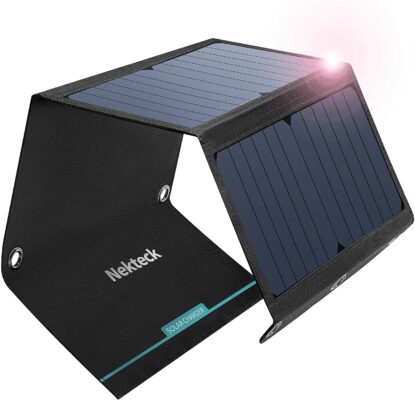
Editor’s Rating:
Quick Facts:
- Type: Monocrystalline
- Usage: USB battery bank charging
- Peak Wattage: 21 watts
- Size: 6.3 x 11.1 x 1.06″ / 1.125 lbs
The Nekteck 21W Solar Charger is a great budget solar panel, and perfect if you’re a hiker looking to keep your phone juiced on your trek through the wilderness.
This solar panel has a lot of surface area, but isn’t heavy. Along with the included metal hooks and built-in grommets, you can easily strap it to your backpack for portable power on the go. And it even comes with a nifty little micro USB charging cable to sweeten the deal a little bit.
It offers a good price-to-wattage ratio for its size. That means it gives you more solar charging power than the Hiluckey panels in the same price range. However, that increased charging efficiency comes at the cost of a built-in battery.
If you already have a portable battery bank, you can’t go wrong with this panel. However, if you don’t already have a portable battery, you should consider getting one to pair with this panel.
A portable battery helps optimize the charging efficiency of the panels. That’s because it’ll help you avoid undercharging your device due to charging fluctuations.
With two USB charging ports, it can put out a max of 3 amps concurrently. This makes it ideal for batteries with dual-input charging ports.
Finally, this panel has an IPX4 waterproof rating. This means that it can withstand splashes of water from any direction, so you won’t have to worry about a little rain ruining your solar panel.
Pros
- Works great for portable battery banks
- Comes with a micro USB cable
- IPX4 waterproof rating
Cons
- Isn't great for charging devices directly
- Doesn't come with a battery
4. Best Universal Portable Solar Panel: Rockpals SP003 100W Foldable Solar Panel
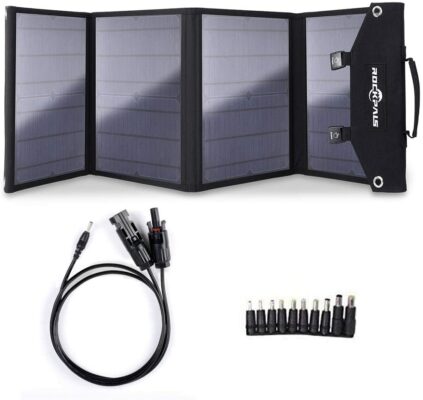
Editor’s Rating:
Quick Facts:
- Type: Monocrystalline
- Usage: Power station/USB device charging
- Peak Wattage: 100 watts
- Size: 20.5 x 14.2 x 2.6″ / 5.1 lbs
If you’re looking for a portable solar panel that’s universally compatible with many power stations and devices, then the Rockpals SP003 100W Foldable Solar Panel is the way to go.
This solar panel from Rockpals comes with 3 USB-A charging ports, one of which is a Quick Charging 3.0 (QC 3.0) port. The QC 3.0 port provides up to 4 times the power of the other conventional USB charging ports, making it great for newer phones and tablets.
It also comes with a built-in smart charging charge controller. That means you won’t need an intermediary battery to get optimal charging to your device.
Additionally, this solar panel comes with an array of different adapters as well. That makes it great for power stations from other brands that use proprietary solar panel charging connections. You should note, however, that the adapters may not make proper contact with the power station’s ports.
But the biggest knock against this panel is that it doesn’t come with a kickstand. This means that you’ll need to hang the panel, lay it flat on the ground, or create your own kickstand to properly angle it for optimal charging.
Overall though, it’s a great choice. It has a water-resistant design, and if you can look past the lack of kickstands, you’ll see why we highly recommend this panel.
Pros
- Includes multiple adapters for different brands of power stations
- 3 USB ports, with one USB 3.0 quick charging port
- Built-in smart charging charge controller for direct device charging
- Water-resistant
Cons
- Adapters may make poor contact
- Doesn't come with a kickstand
5. Best Portable Solar Panel for RVs: Renogy 100 Watt Foldable Solar Panel
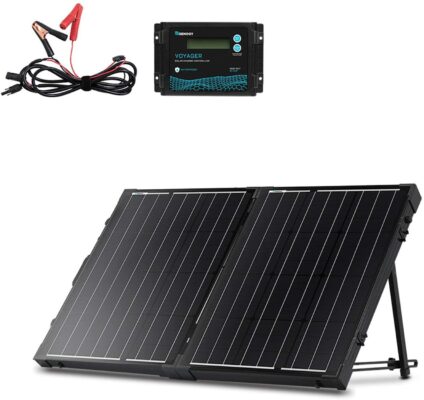
Editor’s Rating:
Quick Facts:
- Type: Monocrystalline
- Usage: Deep cycle battery charging
- Peak Wattage: 100 watts
- Size: 27.2 x 19.9 x 2.8″ / 26.6 lbs
When you think of a portable solar panel, you might think of foldable fabric panels like the Rockpals SP003 100W Foldable Solar Panel. However, some portable solar panels, like the Renogy 100 watt Foldable Solar Panel, are much heavier and sturdier.
That’s because it features a heavy-duty aluminum construction. This makes it durable and sturdy, meaning it won’t easily blow over on a windy day. It also has a built-in adjustable kickstand and a carrying handle, so you can easily fold it up, pack it up, and go.
Of course, its high weight comes at a cost. Particularly, it’s not ideal for hiking excursions and deep wilderness camping.
It also only comes with alligator clips. That means you’ll need to buy an MC4 converter to use it with a power station or other electronics.
Even so, if you’re an RV owner looking to use the sun to power your next camping trip, you’d struggle to find a better panel. And if this panel isn’t beefy enough for you, the company offers a 200-watt variant.
Pros
- Built-in adjustable kickstand and carrying handle
- Heavy-duty aluminum construction
- Excellent for RVs and campers
Cons
- It's quite heavy for a portable panel
- Doesn't come with any adapters for power stations or USB devices
6. Best Portable Solar Panel for Outdoor Adventures: Tranmix Portable Solar Phone Charger
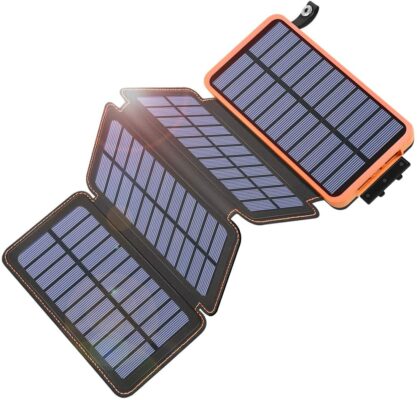
Editor’s Rating:
Quick Facts:
- Type: Thin-film
- Usage: USB device charging
- Peak Wattage: 6 watts
- Size: 6.1 x 3.3 x 1.37″ / 1.18 lbs
If you’re looking to keep your phone charged during your next outdoor adventure, then you should consider the Tranmix Portable Solar Phone Charger.
Like the Hiluckey Outdoor Portable Power Bank, this little solar panel pack comes with a 25,000mAh battery and the ability to provide portable juice for your phone. However, unlike the Hiluckey panels, this solar panel from Tranmix features an impressive IP65 rating.
That means it’s waterproof against low-pressure jets from any angle. But it’s also dustproof and shockproof as well. Talk about a rugged little companion to accompany you to wherever nature takes you.
It also comes with a micro USB cable, and has two USB-A charging ports to provide power for two devices at once. Unfortunately, it doesn’t have quick-charging capabilities.
It also doesn’t come with a USB wall charger, so you’ll need to source one yourself if you want to pre-charge it before your outdoor escapades.
However, the biggest drawback the solar panel has is that the battery discharges quickly. If this was a monocrystalline solar panel, that might not be such a big deal. But being a thin-film solar panel, it’ll take some time for it to charge back up.
Regardless, if you can handle sacrificing a little battery life for durability, then this solar panel is a good option.
Pros
- Built-in 25,000mAh battery
- IP65 waterproof rating means it's great for outdoor activities
- Also shockproof
- Comes with a micro USB cable
Cons
- No quick charging capabilities
- Battery discharges quickly
- Doesn't come with a USB wall charger adapter
7. Best Portable Solar Panel for Light Travel: Topsolar SolarFairy 100W Foldable Solar Panel
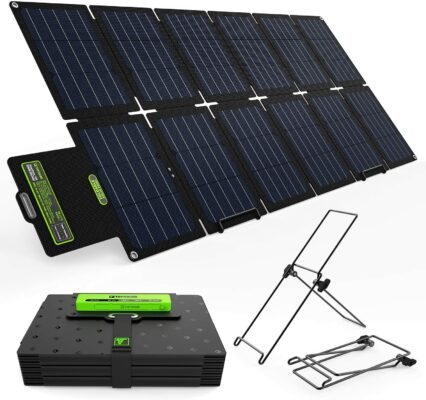
Editor’s Rating:
Quick Facts:
- Type: Monocrystalline
- Usage: Power station/USB device charging
- Peak Wattage: 100 watts
- Size: 52 x 22.4 x 1.7 x 0.95″ / 5.1 lbs
If you’re looking to travel light without skimping on power, then look no further than the Topsolar SolarFairy 100W Foldable Solar Panel.
This set of portable solar panels offers the best of both worlds. It includes 12 solar panels that fold up into a compact size, and is lightweight enough for even the longest treks through the countryside.
This panel also comes with a USB-A and USB-C charging port, and has quick charging capabilities, so you can recharge USB devices quickly. It also comes with tons of adapters and cables, making it a versatile panel for whatever you need to power.
Unfortunately, the included cables are short, so you may need to pick up some extensions. The instructions are also poorly written and rather confusing. This means this panel is not friendly for casual consumers without experience in using solar panels.
Finally the panels don’t have very rigid back support. While they do include two kick stands to help prop them up for optimal charging, they tend to sag because of the lack of extra support.
If you’re looking for something more rigid and sturdy, you might consider the Renogy 100 Watt Foldable Solar Panels. But, if you’re looking to travel light, then these panels are a great choice.
Pros
- High power output for its relative portability
- USB A and C ports with quick charging capabilities
- Comes with tons of adapters and cables for maximum versatility
- Includes 2 kickstands
Cons
- Poor instructions makes it unfriendly for casual consumers
- The included cables are short
- Panels don't have rigid enough back support
8. Best Fabric Portable Solar Panel: Rockpals RP082 100w Foldable Solar Panel Charger
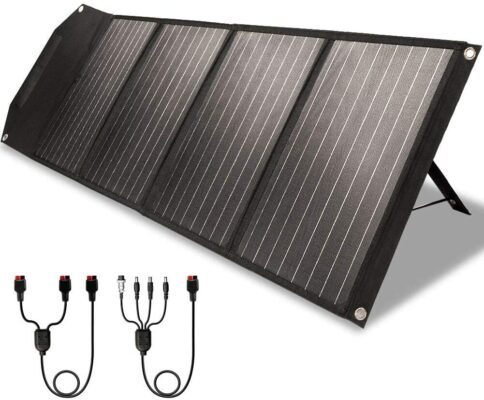
Editor’s Rating:
Quick Facts:
- Type: Monocrystalline
- Usage: Power station/USB device charging
- Peak Wattage: 100 watts
- Size: 68.11 x 17.32 x 1.18″ / 9.48 lbs
If you’re looking for a suitable set of fabric solar panels to take with you on your next camping trip, the Rockpals RP082 100w Foldable Solar Panel Charger is a great choice.
It’s easy to use and lightweight, meaning that you’ll be able to take it anywhere with little issue. It has built-in kickstands that fold out quickly and easily. It also comes with multiple adapters and cables to fit nearly any power station or other device you may use.
It’s also water resistant, so if you decide to leave it back at camp, you shouldn’t have to worry about a little rain ruining your solar panel. You can also use this panel in parallel with another solar panel, making it great if you want to expand your portable solar panel setup later on.
The biggest problem with this solar panel is that it might put out too much voltage for your power station to handle. If you do run into this issue, you’ll need to fold one of the panels up until it reaches the proper voltage for your power station.
Other than that, we only have minor gripes about this panel. It is a bit on the heavier side for foldable fabric panels. And while it does come with two built-in kickstands, it could really benefit from a third kickstand in the middle for added stability and support.
Nonetheless, it’s a great little portable panel that’s easy to use, and is suitable for many power stations and devices.
Pros
- Built-in kickstands that fold out quickly and easily
- Can use them in parallel with another solar panel
- Water-resistant
- Comes with multiple adapters and cables
Cons
- Initial input voltage could be too high
- Could use a third kickstand leg
- A bit on the heavier side for foldable fabric panels
9. Best High-Power Portable Solar Panel: DOKIO 220 Watts Foldable Solar Panel
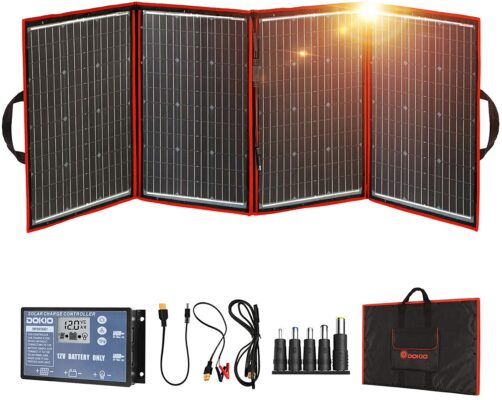
Editor’s Rating:
Quick Facts:
- Type: Monocrystalline
- Usage: Power station/USB device charging
- Peak Wattage: 220 watts
- Size: 21 x 29 x 1.1″ / 11.7 lbs
Last, but certainly not least, is the DOKIO 220 Watts Foldable Solar Panel. If you’re looking for a high-power portable solar panel without breaking the bank, then you’ll definitely want to consider this panel.
This little panel from DOKIO boasts an impressive 220 watt peak wattage, making it the most powerful portable panel on our list.
It includes a charge controller, integrated USB charging ports, multiple adapters, and a set of alligator clips. That means it can charge USB devices, power stations, and 12-volt batteries, making it suitable for nearly any portable power need.
The company also mentions that the panel is waterproof. This is a plus, considering others like the Jackery SolarSaga aren’t even water-resistant. However, there is no mention of an explicit waterproof rating. Because of this, you definitely want to avoid letting this panel get too wet.
That aside, there’s two major flaws with this panel.
The first is the lack of a kickstand. While you can improvise and set the panel against your tent, having a kickstand would greatly benefit this panel.
The second big flaw is not with the panel itself, but the charge controller that comes with it.
The charge controller that comes with the panel is only a 10-amp charge controller. However, at 200+ watts of peak power, the charge controller should be 20 amps for optimal charging efficiency.
Because of this, if you plan to use the panel to charge a 12-volt battery, you’ll want to find a 20-amp charge controller to go along with it. Otherwise, the charging performance may suffer.
But this panel is certainly a worthy contender. It has an excellent price-to-wattage ratio and provides enough versatility for a variety of use cases.
Pros
- Impressive power output for a fabric portable solar panel
- Includes multiple adapters and alligator clips
- Waterproof
- Excellent price-to-wattage ratio
Cons
- Included charge controller isn't powerful enough
- No mention of waterproof rating
- Doesn't come with a kickstand
10. Best Budget Portable Solar Panel: IEsafy 26800mAh Solar Charger
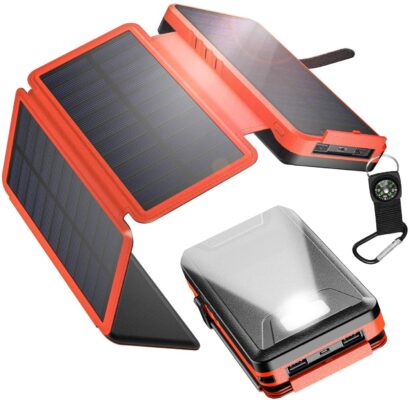
Editor’s Rating:
Quick Facts:
- Type: Thin-film
- Usage: USB device charging
- Peak Wattage: 6 watts
- Size: 7.8 x 3.8 x 1.7″ / 1.4 lbs
If you’re on a strict budget and you’re looking to bring power with you on the go, then the IEsafy 26,800mAh Solar Charger is an excellent choice.
That’s because it combines the best features of other solar phone chargers on our list. Like the Hiluckey, the IEsafy panel features a built-in battery and flashlight. Meanwhile, it features an impressive IP65 waterproof rating, like the Tranmix panel.
But the IEsafy panel is larger than the others, giving it an edge over the others in terms of solar charging. It also comes with a unique compass carabiner, which could prove extremely useful when straying from the beaten path.
However, it has a couple major pitfalls. First, its exceptional battery capacity doesn’t seem to match its real-world performance. Rather, it has a relatively short battery life for 28,500mAh.
The other issue is not an issue with the product itself. Rather, the issue lies in how it’s marketed, and how most people perceive “fast charging.”
The company claims that it features two fast charging USB ports. Technically, at a max power output of 5 volts/2.4 amps each, that’s true. But fast charging is commonly used synonymously with “Quick Charging” or “Power Delivery.” But both standards offer charging at a higher voltage or amperage than this panel.
Of course, if your device doesn’t support these new charging standards, this is a non-issue. But if you have the latest Samsung Galaxy or iPhone, just know that this panel doesn’t offer that extra bit of charging power you might think it does.
Still, with the things it does right, it’s hard to overlook this panel. And you can’t forget that it’s offered at an exceptionally affordable price point
Pros
- Larger solar panels than other comparable models
- Built-in battery and flashlight
- IP65 waterproof rating
- Comes with a unique compass carabiner
- Exceptionally affordable
Cons
- Battery life isn't stellar
- “Fast charging” isn't what you might think it is
Everything You Need to Know About Portable Solar Panels
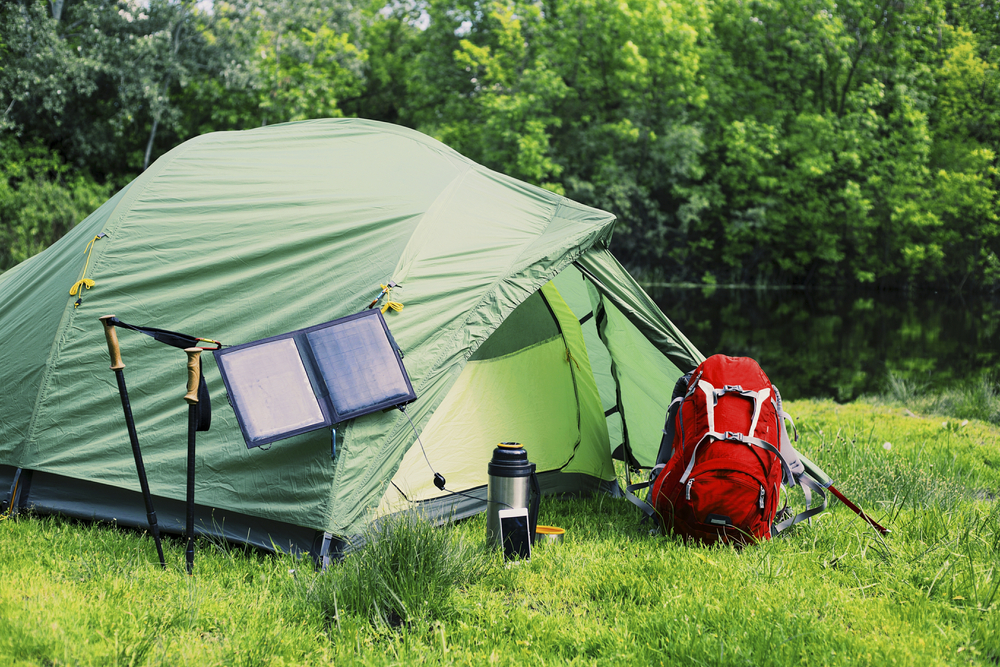
We’ve looked at some of the best portable solar panels we could find. Now, let’s get into some more in-depth topics, such as figuring out how much power you’ll need from your solar panel and how to take care of them.
Figuring Out How Much Power You’ll Need
As we mentioned earlier, figuring out how much power you need from your solar panel is an important consideration to make on shopping for one. But figuring out precisely how much power you’ll need is complex and requires a sophisticated approach to accurately gauge your power needs.
Gauging Your Expectations
First, you’ll need to factor in all the electronic devices you plan on powering over a given period. You’ll need to start by gauging the amount of power each device uses, and how long you plan on powering them.
To figure out how much power a device uses, there’s a couple of ways you can go about it. One way is to consult the manual. This should give you an idea of what kind of wattage each of your devices requires to run for a single hour.
Another way of figuring out how much power a device uses is by using a power monitor, such as a Kill-A-Watt monitor, to read and record power usage in real time. This is by far the most effective way to measure the power requirements of your devices and offers a more reasonable real-world estimate.
Plan for the Time You Expect to Use Your Devices
Once you’ve gauged how much power your devices use, then figure out how much you plan to use them. So if you’ve determined that your laptop uses 50 watts an hour, then you’ll need to figure out how much time you plan to use it while you’re out.
But estimating the time you plan to use your device isn’t the only thing you should plan for. There’s a lot you have to look for.
Expect the Unexpected
Sometimes things take a turn for the worst, so you’ll want to factor that into the equation.
For example, say you’re planning a weekend camping trip. You expect to use most of your time hiking, fishing, or hunting, while your solar panel charges your laptop back at camp. However, you may find your trip dampened by an unexpected thunderstorm, forcing you to stay inside at camp.
Now your solar panels are now effectively useless until things clear up, and you now decide to use your laptop while you wait for the storm to blow over.
Obviously, the more important your electronics are, the more important it is to prepare for the worst. That could mean bringing an extra pre-charged battery bank, an extra set of solar panels, or maybe even a small gas generator for backup if you absolutely need electricity.
How to Clean Your Portable Solar Panels
Solar panels are frequently exposed to the elements. But portable panels are unique in that they’re exposed to so much more than rooftop panels; fingerprints, spilled drinks, and muddy adventures, to name a few.
Keeping your solar panels clean is an important part of maintenance, though it’s also easy to overlook. But, before you haphazardly reach for your cleaning chemicals, take a moment to learn how to properly clean them, so you don’t accidentally damage them.
Cleaning Your Solar Panels
The first thing you should do is disconnect the panels from any devices you have the panels plugged into. If possible, you’ll also want to disconnect the charge controller from the panels. Next, bring them inside or to an area where they won’t get any direct sunlight to stop them from charging.
Once they’re disconnected from any electronics and out of the sun, grab a soft cloth. You’ll want to dampen the cloth with a low-mineral water, such as distilled or ionized water. Using regular tap water can leave mineral deposits behind, which will cause your panels to become cloudy.
You’ll also want to avoid using hot or cold water, and to ring out any excess water before you clean your solar panels. This will help prevent water from making its way inside the panels.
Wipe or gently scrub the panels with your damp cloth. Take care not to push too hard when wiping, as too much pressure may cause the solar cells to crack. Once you’re done wiping the panels, follow up with a dry microfiber cloth to soak up any excess moisture, in order to avoid streaking and water spots.
What About Cleaning With Chemicals?
You want to avoid using any kind of cleaning solutions on your solar panels. That’s because many chemicals contain micro-abrasive detergents or solvents that can damage the surface and cause the panels to cloud up.
But we aren’t just talking Windex and rubbing alcohol here – this includes soap as well, since it often leaves behind a film of its own.
If you have sticky residue that won’t come off with water alone (such as tree sap), then you might use a small amount of gentle dish soap and water to clean the area. But even then, you’ll still want to proceed with caution, as doing so may void the warranty on your solar panels.
Why Don’t My Solar Panels Reach Their Advertised Charging Output?
The peak wattage rating any given solar panel has is its theoretical maximum, based on laboratory testing. The actual energy output of a solar panel largely depends on the amount and intensity of light hitting the solar panel, as well as changes in lighting over time, and the temperature of the panels.
Your geolocation and the time of year also play a large part in determining the power your panels can actually generate.
What that means is that real world numbers are far more likely to be in the 50% to 75% range of the stated maximum output. So a 100-watt solar panel is likely to generate somewhere between 50 and 75 watts of power.
Of course, it is possible you may have a defective solar panel. One way to check this is by using another panel with similar specs at the same time to see if it puts out a significantly different amount of power.
In any case, it’s important to remember to temper your expectations. With so many variables at play, you’re highly unlikely to get the stated maximum output out of your panels in a real-world environment.
Tips for Getting the Most out of Your Solar Panels
There’s a lot of variables that factor into the efficiency of your solar panel that are completely out of your control. With that said, let’s look at some things that you can control, that will get you the most out of your solar panels.
Use Solar Panels Under Direct Sunlight
Solar panels work best when they are outside under direct sunlight. While they will work in the shade or behind a window, these obstructions can greatly diminish the efficiency of any solar panel.
Keep All of Your Solar Panels Uncovered
Many foldable solar panels require that each panel remains uncovered to work properly. If you find your panels aren’t charging at all, make sure each panel is fully uncovered and exposed to direct sunlight.
Keep Your Solar Panels Clean
Keeping your solar panels clean is another way to ensure they work as they should. In case you missed it, we covered some cleaning tips, so you can keep your solar panels clean without damaging them.
Try to Keep Your Solar Panels Dry
We all know water and electricity don’t mix. Many portable solar panels offer water-resistance, but few offer any meaningful waterproofing. Because of this, it’s important to keep your solar panels and their charge controllers as dry as possible.
Don’t Bend Your Solar Panels More Than 30 Degrees
Many portable solar panels are thin and come in cloth cases. However, you should still take care to not bend your solar panels any more than necessary. Bending them by more than 30 degrees can cause the cells to break, rendering them useless.
What Is QC 3.0 and PD 3.0 USB?
You may notice when looking at portable solar panels that some panels come with PD 3.0 or QC 3.0 USB charging ports. But what does that mean?
PD stands for Power Delivery. QC stands for Quick Charging.
Each standard offers unique benefits depending on your device. But both charging standards offer a common benefit over regular USB 2.0 charging ports: higher power output. This means that if your device is compatible with either charging standard, PD or QC 3.0 ports will charge those devices more quickly than standard USB charging ports.
Wrapping Up
Finding the right portable solar panel for you can be overwhelming at first. However, knowing what to look for and how to plan accordingly is helpful for finding the right panel for you.
Once you’ve picked your solar panel, all that’s left to do is plan and prepare for that epic family camping trip you’ve been wanting to take. After all, who doesn’t like a little fun in the sun?
